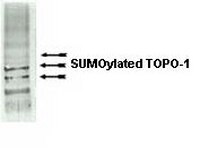SUMO, ubiquitin's mysterious cousin.
Müller, S, et al.
Nat. Rev. Mol. Cell Biol., 2: 202-10 (2001)
2001
Show Abstract
Covalent modification of cellular proteins by the ubiquitin-like modifier SUMO regulates various cellular processes, such as nuclear transport, signal transduction, stress response and cell-cycle progression. But, in contrast to ubiquitylation, sumoylation does not tag proteins for degradation, but seems to enhance their stability or modulate their subcellular compartmentalization. | 11265250
 |
SUMO/sentrin: protein modifiers regulating important cellular functions.
Kretz-Remy, C and Tanguay, R M
Biochem. Cell Biol., 77: 299-309 (1999)
1999
Show Abstract
Regulation of protein functions can be achieved by posttranslational protein modifications. One of the most studied modifications has been conjugation to ubiquitin, which mainly targets substrate proteins for degradation by the 26 S proteasome. Recently, SUMO/sentrin, a ubiquitin-like protein has been characterized. This evolutionary conserved protein is conjugated to specific proteins in a way similar, but not identical, to ubiquitin and seems also to be involved in the regulation of protein localization or function. An increasing number of SUMO/sentrin substrates are currently described. We focus here on three major substrates of modification by SUMO: RanGAP1, PML, and IkappaBalpha proteins. These different examples illustrate how SUMO conjugation may be involved in the control of the level of critical proteins within the cell or in the modulation of subcellular localization and nucleocytoplasmic trafficking. | 10546893
 |










